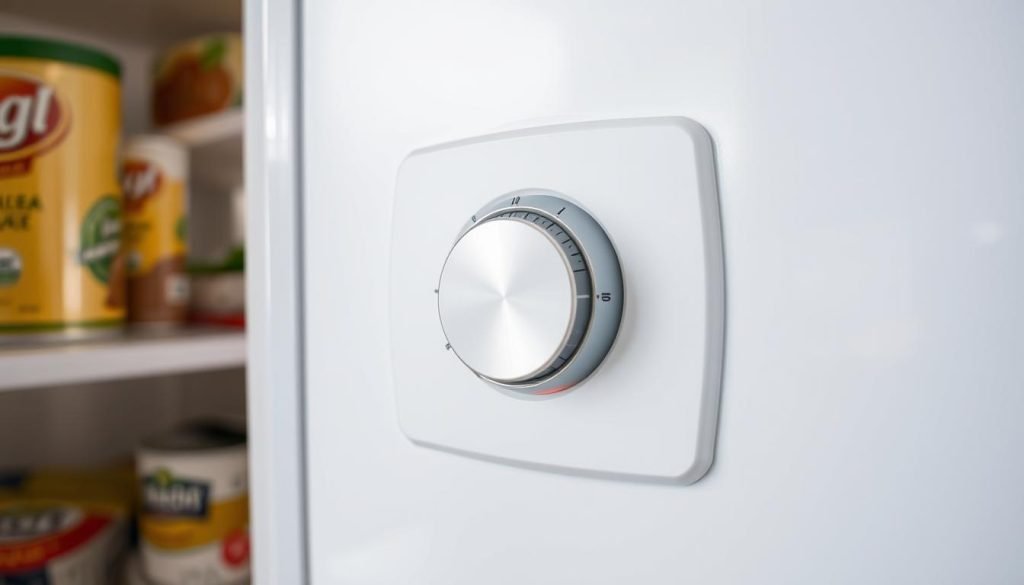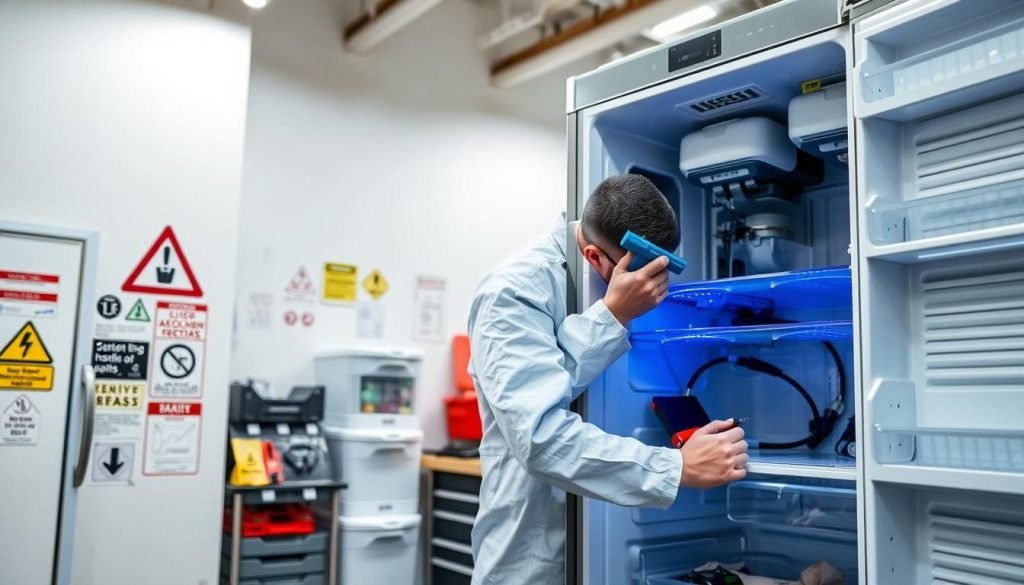A malfunctioning refrigerator can really mess up your plans, more so in the summer. Many homes struggle with their fridge’s cooling at some point.
If your fridge isn’t cooling right, it can ruin your food. But, finding and fixing the problem is easier than you might think.
With a few simple steps, you can figure out and maybe even fix the issue. This article will show you how to get your fridge working like new again.
Key Takeaways
- Common causes of a refrigerator not cooling
- Steps to diagnose the cooling issue
- Simple fixes to get your refrigerator working again
- When to call a professional for help
- Tips to maintain your refrigerator’s efficiency
Common Reasons Your Refrigerator Is Not Cooling
Refrigerators are complex appliances. When they don’t cool, it’s often due to a few common issues. Knowing these can help you find and fix the problem.
Dirty Condenser Coils
Dirty condenser coils are a common refrigerator condenser issue. These coils help get rid of heat from the fridge. When they’re clogged with dust, the fridge can’t cool well. To fix this, unplug the fridge and clean the coils with a vacuum or a coil brush.
Faulty Door Seals
Faulty door seals can also cause cooling problems. If the seals are damaged, cold air can leak out. This makes the fridge work harder and can increase your energy bills. Check the seals for wear and replace them if needed. A tight seal keeps the fridge cool.
Thermostat Issues
Thermostat issues can also cause problems. The thermostat controls the fridge’s temperature. If it’s not working right, the fridge won’t cool. Check your thermostat settings. If it’s still not working, you might need a professional to replace it.
By fixing these common issues, you can often get your fridge cooling again. Regular maintenance, like cleaning coils and checking seals, can prevent many problems.
Initial Steps to Diagnose the Problem
To fix a fridge that’s not cold, start with the basics. Finding the problem early can save you money and keep your fridge working well.
Check Power Supply
First, make sure your fridge has power. Check if it’s plugged in right and if the circuit breaker is okay. Sometimes, a simple fix is a loose plug or a blown fuse.
Verify the Outlet: Plug another device into the outlet to check if it works. If it doesn’t, look at your home’s electrical panel.
Tip: Don’t use extension cords with your fridge. They can lower the voltage and hurt its performance.
Ensure Proper Ventilation
Good airflow is key for your fridge’s work. Make sure nothing blocks the vents around it.
- Leave at least 1 inch of space between the fridge and the wall.
- Make sure the fridge’s vents are clear.
- Keep the condenser coils clean to help airflow.
| Check | Description | Action |
|---|---|---|
| Power Supply | Check if the refrigerator is properly plugged in and if the outlet is working. | Verify the plug and outlet. |
| Ventilation | Ensure that the vents around the refrigerator are not blocked. | Clear any obstructions around the vents. |
Inspecting the Temperature Settings
Checking and tweaking the temperature settings is a simple way to figure out why your fridge isn’t cold enough. The settings are key to how well your fridge works. Changing them might fix the cooling problem.

Adjusting the Thermostat
The thermostat keeps your fridge at the right temperature. If it’s too high, your fridge won’t cool right. Find the temperature control dial inside or on the front of your fridge.
Turn the dial to a colder setting. Wait a few hours to see if it gets colder. Letting the fridge adjust is important. If it gets better, you fixed it. But if not, you might need to look deeper.
“A well-adjusted thermostat is key to maintaining optimal refrigerator performance.”
Understanding Temperature Zones
Today’s fridges have different zones for different foods. Knowing about these zones helps your fridge work better.
The freezer should be between 0°F and 5°F. The fridge should be around 37°F to 40°F. Adjusting these can keep your fridge at the right temperature.
| Compartment | Ideal Temperature Range |
|---|---|
| Freezer | 0°F to 5°F (-18°C to -15°C) |
| Refrigerator | 37°F to 40°F (3°C to 4°C) |
By tweaking the thermostat and knowing about temperature zones, you can solve the fridge not being cold enough. If it still doesn’t work, it might need a pro to fix.
Cleaning and Maintenance Tips
To keep your refrigerator running well, cleaning and maintenance are key. A clean fridge cools better and lasts longer. This saves you money on energy and replacement costs.
Regularly Clean Condenser Coils
The condenser coils are crucial for cooling. They get dusty over time, which lowers their efficiency. To clean them, first, unplug your fridge for safety.
Then, find the coils at the back or bottom. Use a vacuum with a brush to remove dust. For a deeper clean, a coil brush works great.
Maintaining Proper Airflow
Good airflow is key for the right temperature. Make sure vents inside aren’t blocked. Also, avoid overloading your fridge.
Enough space around the fridge is important for airflow. This helps keep it cool.
| Maintenance Task | Frequency | Benefits |
|---|---|---|
| Clean Condenser Coils | Every 6 months | Improves cooling efficiency, reduces energy consumption |
| Check and Replace Door Seals | Every 1-2 years | Prevents cold air leakage, maintains optimal temperature |
| Defrost Freezer | Every 6-12 months | Maintains freezer efficiency, prevents ice buildup |
By following these tips, your fridge will work better and last longer. Regular care keeps it cool and saves energy. This means you’ll spend less on bills and replacements.
Troubleshooting Electrical Components
Figuring out why your fridge isn’t cooling is key. Electrical problems can be tricky, but knowing how to spot and fix them can save you a lot of hassle and cash.
Testing the Start Relay
The start relay is vital for starting the compressor. Without it, your fridge won’t cool. To check it, you’ll need a multimeter. First, unplug your fridge and find the start relay, usually on the compressor or fridge side.
Steps to Test the Start Relay:
- Take out the relay from its housing.
- Use a multimeter to see if there’s continuity between the terminals.
- If there’s no continuity, the relay is bad and needs to be swapped out.
Be careful when working with electrical parts to avoid getting shocked or hurt.
Evaluating the Compressor Function
The compressor is the core of your fridge’s cooling system. If it’s not working, your fridge won’t cool. Listen for any odd noises. A good compressor makes a humming or buzzing sound.
Signs of a Faulty Compressor:
- No humming or buzzing when you turn on the fridge.
- It’s overheating or vibrating too much.
To get a closer look, use a multimeter to check the compressor’s electrical circuit for continuity. Any problems might mean the compressor is the issue.
Here’s a quick rundown of the main parts and their possible problems in a table:
| Component | Potential Issue | Diagnostic Method |
|---|---|---|
| Start Relay | Failure to start the compressor | Multimeter test for continuity |
| Compressor | Not cooling, unusual noises | Listening for operational sounds, multimeter test |
By following these steps and knowing about key electrical parts, you can troubleshoot and fix issues making your fridge not cool.
When to Call a Professional Technician
Knowing when to call a professional can save you from a big headache. If your fridge problems go beyond simple fixes, it’s time to get expert help.
Identifying Major Issues
Big fridge problems, like a broken compressor or electrical issues, need a pro. Ignoring these can cause more damage and higher energy bills.
Here are signs of major fridge problems:
- Unusual noises from the compressor or motor
- Water leaking from the fridge
- Uneven cooling or freezing
| Issue | Possible Cause | Recommended Action |
|---|---|---|
| Unusual Noises | Faulty Compressor or Motor | Call a Professional Technician |
| Water Leakage | Clogged Drain or Faulty Water Inlet Valve | Inspect and Clean/Replace as Necessary |
| Inconsistent Cooling | Thermostat Issues or Refrigerant Leaks | Check Thermostat Settings, Call Professional if Necessary |
Safety Considerations
Your safety is the most important thing when fixing appliances. A top appliance repair expert says,
“Safety is not just about avoiding injuries; it’s also about preventing further damage to your appliance and your home.”
Key safety tips include:
- Make sure the appliance is unplugged before starting repairs
- Watch out for sharp edges and moving parts
- Don’t touch electrical parts with wet hands to avoid shock

If you’re not sure about a repair or feel uneasy, call a pro. They have the skills and tools to fix complex problems safely and quickly.
Repair vs. Replace: Making the Decision
When your fridge stops cooling, you face a big choice: fix it or get a new one. This choice depends on repair costs, your fridge’s age, and your budget. Knowing these points helps you decide wisely.
Cost Analysis of Repairs
Doing a cost analysis of repairs is key. Think about:
- The repair cost versus a new fridge’s price
- Your fridge’s age and condition
- How often it breaks down and needs fixing
If fixing it costs more than half of a new fridge, getting a new one might save you money in the long run.
Signs You Need a New Refrigerator
Some signs mean it’s time to replace your refrigerator instead of fixing it. Watch for:
- Higher energy bills because it’s not efficient
- It breaks down a lot and needs repairs
- It’s old: fridges usually last 10 to 15 years
If your fridge is close to or past this age, it might be time for a new one.
Preventative Measures for Future Issues
To avoid future cooling issues, it’s essential to take preventative measures. This way, you can make your refrigerator last longer and work better.
As routine maintenance is crucial, let’s explore some key practices. “Regular maintenance is the key to a well-functioning refrigerator,” as emphasized by appliance experts.
Implementing Routine Maintenance
Routine maintenance involves several tasks, including:
- Regularly cleaning the condenser coils to ensure proper heat dissipation
- Checking and replacing worn-out door seals to maintain the internal temperature
- Verifying that the refrigerator is level to prevent uneven wear on the compressor
Keeping the Refrigerator Organized
Maintaining a well-organized refrigerator is also vital. Overcrowding can obstruct airflow, causing the appliance to work harder and potentially leading to cooling issues. To avoid this, ensure that:
- There is adequate space between items for air to circulate
- Expired or unused items are removed regularly
- Food is stored in airtight containers to prevent moisture buildup
By implementing these preventative measures, you can significantly reduce the likelihood of future cooling issues and keep your refrigerator running smoothly.
“A well-maintained refrigerator is a key to a hassle-free kitchen,” said a renowned appliance expert.
Conclusion: Restoring Your Refrigerator’s Functionality
By following the steps in this article, you can find and fix your fridge’s cooling problem. This not only saves money but also makes your fridge last longer.
Key Steps to Success
Important steps include checking the power, making sure it’s well-ventilated, and looking at the temperature settings. Also, don’t forget to clean the condenser coils regularly. These steps help you figure out and maybe fix the cooling issue.
Take Action Today
Don’t let a broken fridge mess up your day. Use what you learned here to fix your fridge. It might be an easy fix or you might need a pro. Either way, acting fast saves you time and money.
FAQ
Why is my refrigerator not cooling, but the freezer is working?
A faulty evaporator fan, clogged air vent, or malfunctioning damper control might be the cause. Check if the evaporator fan is running and if the air vents are clear. If the problem continues, it’s best to get professional help.
How do I troubleshoot a refrigerator that’s not cooling?
First, ensure the refrigerator is plugged in and the outlet works. Next, clean the condenser coils and check the door seals for damage. Also, verify the thermostat settings and ensure good ventilation around the fridge.
What are the common causes of a refrigerator not cooling?
Dirty condenser coils, faulty door seals, thermostat problems, and issues with the evaporator fan or compressor are common causes. Regular maintenance, like cleaning the condenser coils, can prevent these problems.
Can a faulty compressor cause my refrigerator to not cool?
Yes, a faulty compressor can stop your fridge from cooling. The compressor is key for cooling by compressing refrigerant. If it fails, the fridge won’t cool.
How often should I clean the condenser coils on my refrigerator?
Clean the condenser coils every 6-12 months, depending on usage and environment. Dirty coils can greatly reduce cooling performance.
What temperature should my refrigerator be set to?
Set your fridge to 37°F to 40°F (3°C to 4°C) for best cooling. Adjusting the thermostat to this range helps ensure proper cooling.
Can I fix a refrigerator not cooling issue on my own?
You can fix simple issues like dirty coils or faulty door seals yourself. But, complex problems like a faulty compressor might need a pro.
How do I know if my refrigerator’s evaporator fan is working?
Listen for the fan’s humming noise or check if it spins when you open the freezer. If it’s not working, it might need to be replaced.
What are the signs that I need to replace my refrigerator?
Increased energy bills, frequent breakdowns, and age over 10-15 years are signs you might need a new fridge. If repairs are too frequent or expensive, it’s time to consider a new one.







